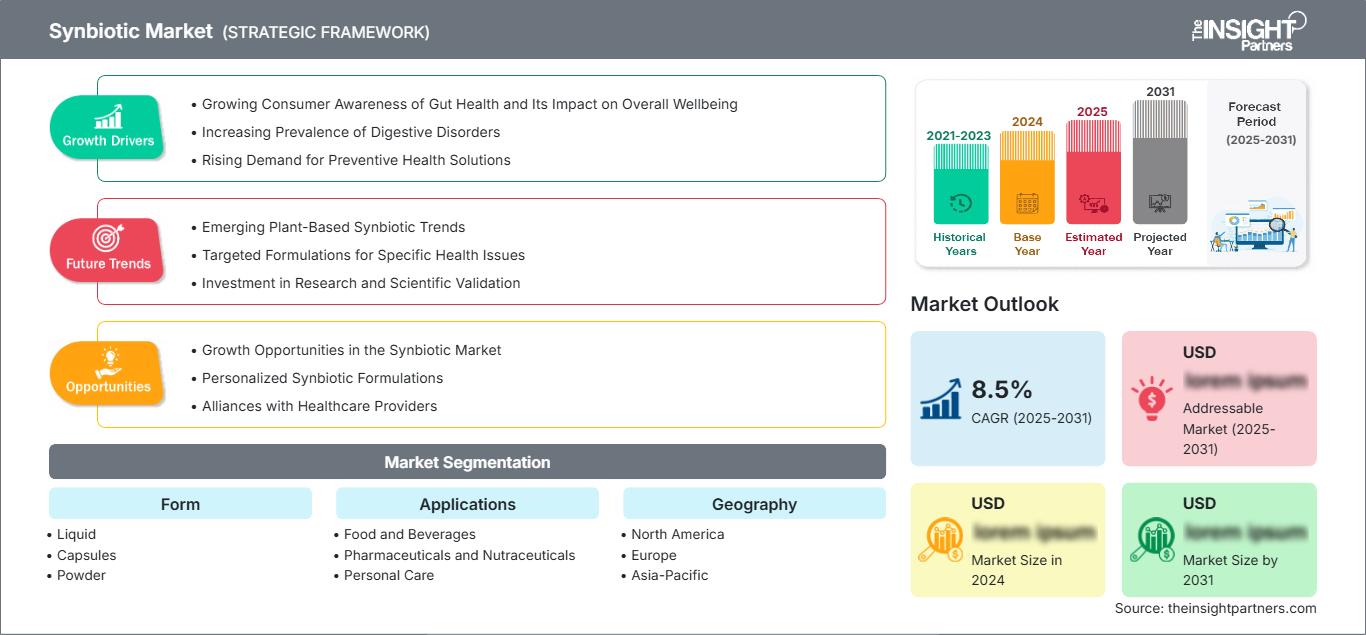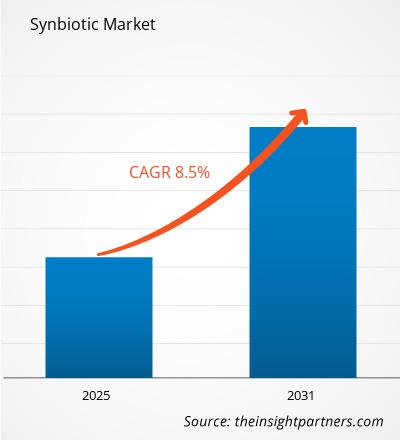Si prevede che il mercato dei prodotti sinbiotici registrerà un CAGR dell'8,5% dal 2025 al 2031, con una dimensione del mercato in espansione da XX milioni di dollari nel 2024 a XX milioni di dollari entro il 2031.
Il rapporto è segmentato per forma (liquido, capsule e polvere). Il rapporto presenta inoltre un'analisi basata sulle applicazioni (alimenti e bevande, prodotti farmaceutici e nutraceutici, cura della persona, nutrizione animale e altri). L'ambito del rapporto copre cinque regioni: Nord America, Europa, Asia Pacifico, Medio Oriente e Africa, Sud e Centro America e i paesi chiave di ciascuna regione. L'analisi globale è ulteriormente suddivisa a livello regionale e per paesi principali. Il rapporto offre il valore in USD per l'analisi e i segmenti sopra indicati.
Scopo del rapporto
Il rapporto "Synbiotic Market" di The Insight Partners mira a descrivere il panorama attuale e la crescita futura, i principali fattori trainanti, le sfide e le opportunità. Ciò fornirà spunti a vari stakeholder aziendali, come:
- Fornitori/produttori di tecnologia: per comprendere le dinamiche di mercato in evoluzione e conoscere le potenziali opportunità di crescita, consentendo loro di prendere decisioni strategiche informate.
- Investitori: per condurre un'analisi completa delle tendenze in merito al tasso di crescita del mercato, alle proiezioni finanziarie del mercato e alle opportunità esistenti lungo la catena del valore.
- Organismi di regolamentazione: per regolamentare le politiche e le attività di controllo nel mercato con l'obiettivo di ridurre al minimo gli abusi, preservare la fiducia degli investitori e sostenere l'integrità e la stabilità del mercato.
Forma di segmentazione del mercato simbiotico
- Liquido
- Capsule
- Polvere
Applicazioni
- Alimenti e bevande
- Prodotti farmaceutici e nutraceutici
- Cura della persona
- Nutrizione animale
- Altri
Potrai personalizzare gratuitamente qualsiasi rapporto, comprese parti di questo rapporto, o analisi a livello di paese, pacchetto dati Excel, oltre a usufruire di grandi offerte e sconti per start-up e università
Mercato sinbiotico: Approfondimenti strategici

-
Ottieni le principali tendenze chiave del mercato di questo rapporto.Questo campione GRATUITO includerà l'analisi dei dati, che vanno dalle tendenze di mercato alle stime e alle previsioni.
Fattori di crescita del mercato dei sinbiotici
- Crescente consapevolezza dei consumatori sulla salute intestinale e il suo impatto sul benessere generale: nel tempo, sempre più persone stanno comprendendo la necessità di un intestino sano per il loro benessere generale. L'impatto reale li rende più consapevoli di quanto sia importante per l'apparato digerente, la funzione immunitaria, la salute mentale e le malattie della pelle. Questa crescente consapevolezza è ciò che spinge la stragrande maggioranza a cercare prodotti per la salute intestinale come i sinbiotici. I sinbiotici combinano probiotici e prebiotici per supportare la salute dell'intestino.
- Crescente prevalenza di disturbi digestivi: la crescente prevalenza di disturbi digestivi e condizioni di salute associate a un microbioma intestinale sbilanciato è evidente. La ricerca trova collegamenti tra squilibri del microbioma intestinale e condizioni come obesità, diabete e malattie autoimmuni. Poiché questi problemi diventano sempre più comuni, le persone stanno accedendo all'applicazione di prodotti che supportano l'intestino come i sinbiotici.
- Crescente domanda di soluzioni per la salute preventiva: la domanda di soluzioni per la salute naturale e preventiva è in aumento, poiché i consumatori preferiscono rimedi naturali. I simbiotici rappresentano un modo naturale per migliorare la salute intestinale, attraendo così un maggior numero di consumatori.
Tendenze future del mercato dei simbiotici
- Tendenze emergenti dei simbiotici a base vegetale: le attuali tendenze dei simbiotici sul mercato riguardano i nuovi prodotti a base vegetale e vegani, che riflettono la crescente domanda dei consumatori di scelte alimentari più sane e sostenibili. Questa tendenza è appropriata, poiché i consumatori fanno sempre più scelte di stile di vita e la salute intestinale e il benessere generale sono allineati.
- Formule mirate per specifici problemi di salute: si registra una forte tendenza allo sviluppo di miscele simbiotiche specifiche per specifici problemi di salute. I produttori cercano sempre più spesso di produrre formulazioni specifiche per problemi come la salute digestiva, il supporto immunitario e il benessere mentale. Questa tendenza aumenta la consapevolezza dei consumatori e dà impulso alla domanda di prodotti simbiotici speciali con benefici mirati.
- Investimenti in ricerca e validazione scientifica: il mercato dei simbiotici sta investendo sempre di più in ricerca e sperimentazioni cliniche per stabilire la validità delle indicazioni sulla salute e scoprire nuove formulazioni. Una richiesta sempre crescente di validazione scientifica dei prodotti durante il loro processo di sviluppo ha contribuito a costruire la fiducia dei consumatori. Poiché tali sforzi stanno aumentando la credibilità dei prodotti simbiotici e aprendo le porte a ulteriori innovazioni, stanno sicuramente vincendo la partita.
Opportunità di mercato dei simbiotici
- Opportunità di crescita nel mercato dei simbiotici: il mercato dei simbiotici presenta significative opportunità di crescita in nuove categorie di prodotti, esclusi i tradizionali prodotti lattiero-caseari. La partecipazione di segmenti come bevande, snack e integratori alimentari renderà i simbiotici più accessibili a un vasto pubblico e soddisferà le diverse preferenze dei consumatori, migliorando al contempo l'accesso ai benefici dei simbiotici nella dieta quotidiana.
- Formulazioni simbiotiche personalizzate: le formulazioni simbiotiche personalizzate, adattate al microbioma specifico di ogni individuo, rappresenteranno un'opportunità insolita all'interno del mercato. Man mano che un individuo diventa più attento alla salute, l'attenzione verso questi prodotti più mirati per la salute intestinale diventerà insolita. I prodotti personalizzati sono associati a una maggiore efficacia, il che incoraggia la fidelizzazione dei consumatori e l'innovazione all'interno delle linee di prodotti simbiotici.
- Alleanze con gli operatori sanitari: il mercato dei simbiotici potrebbe presentare una potenziale opportunità di stringere alleanze con gli operatori sanitari. L'integrazione dei simbiotici in un trattamento e in una terapia medica migliora la cura dei pazienti e promuove strategie di salute preventiva per i produttori. Inoltre, la consapevolezza e l'accettazione dei simbiotici come componenti del benessere olistico possono essere aumentate attraverso la partnership tra un produttore e gli operatori sanitari.
Approfondimenti regionali sul mercato simbiotico
Le tendenze regionali e i fattori che influenzano il mercato dei prodotti simbiotici durante il periodo di previsione sono stati ampiamente spiegati dagli analisti di The Insight Partners. Questa sezione illustra anche i segmenti e la geografia del mercato dei prodotti simbiotici in Nord America, Europa, Asia-Pacifico, Medio Oriente e Africa, America meridionale e centrale.
Ambito del rapporto sul mercato simbiotico
| Attributo del rapporto | Dettagli |
|---|---|
| Dimensioni del mercato in 2024 | US$ XX million |
| Dimensioni del mercato per 2031 | US$ XX Million |
| CAGR globale (2025 - 2031) | 8.5% |
| Dati storici | 2021-2023 |
| Periodo di previsione | 2025-2031 |
| Segmenti coperti |
By Forma
|
| Regioni e paesi coperti |
Nord America
|
| Leader di mercato e profili aziendali chiave |
|
Densità degli attori del mercato simbiotico: comprendere il suo impatto sulle dinamiche aziendali
Il mercato dei prodotti sinbiotici è in rapida crescita, trainato dalla crescente domanda degli utenti finali, dovuta a fattori quali l'evoluzione delle preferenze dei consumatori, i progressi tecnologici e una maggiore consapevolezza dei benefici del prodotto. Con l'aumento della domanda, le aziende stanno ampliando la propria offerta, innovando per soddisfare le esigenze dei consumatori e sfruttando le tendenze emergenti, alimentando ulteriormente la crescita del mercato.

- Ottieni il Mercato sinbiotico Panoramica dei principali attori chiave
Punti di forza
- Copertura completa: il rapporto copre in modo completo l'analisi di prodotti, servizi, tipologie e utenti finali del mercato dei simbiotici, fornendo un panorama olistico.
- Analisi degli esperti: il rapporto è compilato sulla base della conoscenza approfondita di esperti e analisti del settore.
- Informazioni aggiornate: il rapporto garantisce la pertinenza aziendale grazie alla sua copertura di informazioni recenti e tendenze dei dati.
- Opzioni di personalizzazione: questo rapporto può essere personalizzato per soddisfare le esigenze specifiche del cliente e adattarsi in modo appropriato alle strategie aziendali.
Il rapporto di ricerca sul mercato dei simbiotici può, quindi, aiutare a guidare il percorso di decodificazione e comprensione dello scenario del settore e delle prospettive di crescita. Sebbene possano esserci alcune preoccupazioni valide, i vantaggi complessivi di questo rapporto tendono a superare gli svantaggi.
- Analisi storica (2 anni), anno base, previsione (7 anni) con CAGR
- Analisi PEST e SWOT
- Valore/volume delle dimensioni del mercato - Globale, Regionale, Nazionale
- Industria e panorama competitivo
- Set di dati Excel
Report recenti
Rapporti correlati
Testimonianze
Motivo dell'acquisto
- Processo decisionale informato
- Comprensione delle dinamiche di mercato
- Analisi competitiva
- Analisi dei clienti
- Previsioni di mercato
- Mitigazione del rischio
- Pianificazione strategica
- Giustificazione degli investimenti
- Identificazione dei mercati emergenti
- Miglioramento delle strategie di marketing
- Aumento dell'efficienza operativa
- Allineamento alle tendenze normative






















 Ottieni un campione gratuito per - Mercato sinbiotico
Ottieni un campione gratuito per - Mercato sinbiotico